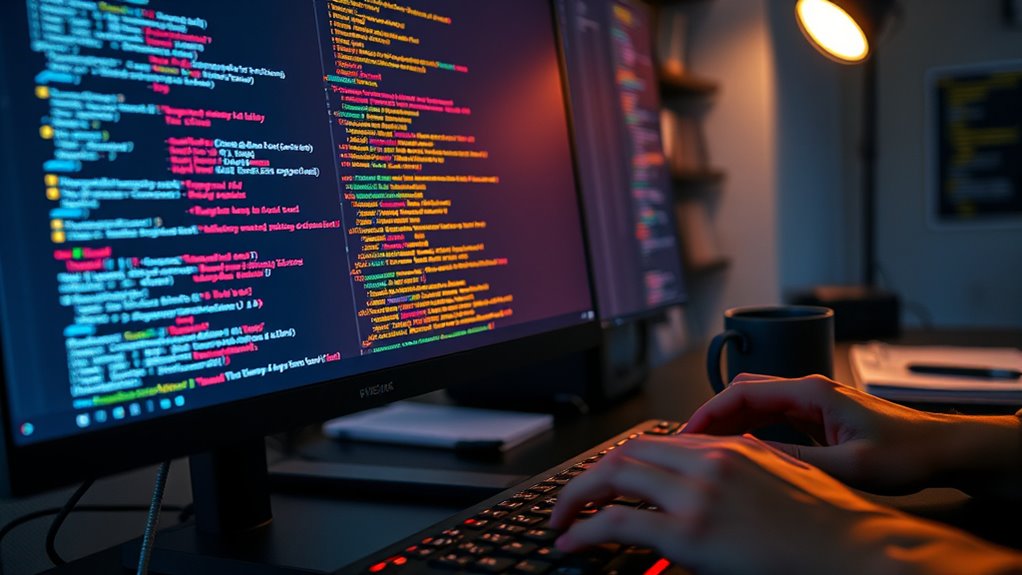AI-assisted code refactoring combined with automated testing helps you modernize legacy projects efficiently. It systematically identifies redundant code, inefficient algorithms, and structural issues while ensuring existing functionality stays intact. This approach reduces technical debt, minimizes bugs, and accelerates system updates. By verifying changes continuously, you gain confidence in your modernization efforts. If you continue, you’ll discover detailed insights into how these technologies transform complex legacy systems and boost long-term project success.
Key Takeaways
- The case study highlights how AI-driven analysis identified redundant and inefficient code segments in a legacy system.
- Automated testing was integrated to verify that refactoring efforts preserved existing functionality during modernization.
- AI-guided refactoring enabled systematic restructuring, reducing technical debt and improving code maintainability.
- The combined AI and testing approach accelerated project timelines while minimizing the risk of introducing bugs.
- Overall, the project resulted in a more robust, scalable, and easier-to-maintain codebase, ensuring long-term system stability.

As software projects grow in complexity, maintaining clean and efficient code becomes increasingly challenging. If you’re working with legacy code, you know how difficult it can be to introduce new features or fix bugs without risking unintended consequences. Over time, legacy systems often become tangled and hard to understand, which hampers development speed and quality. That’s where automated testing becomes a pivotal tool. Automated tests help you verify that changes don’t break existing functionality, giving you confidence to refactor and modernize codebases safely.
Legacy code challenges are eased with automated testing, ensuring safe refactoring and continuous delivery of reliable software.
In this context, AI-assisted code refactoring offers a game-changing solution. Instead of manually sifting through complex, outdated code, you can leverage AI tools to identify areas that need improvement. These tools analyze the structure and patterns within your legacy code, highlighting redundant sections, inefficient algorithms, or poorly organized modules. By doing so, AI helps you plan a more systematic refactoring process, reducing the risk of introducing new bugs. Additionally, these AI tools often incorporate code analysis techniques that improve their accuracy in detecting problematic code segments.
Once you’ve identified what needs to change, automated testing plays an essential role in guaranteeing your modifications are safe. When you combine AI-driven suggestions with a comprehensive suite of automated tests, you can quickly verify that your refactored code maintains the original functionality. This synergy accelerates the overall process, allowing you to make significant improvements without the fear of breaking critical features. Automated tests serve as a safety net, confirming that each change preserves system integrity as you incrementally improve the codebase. Moreover, employing test automation tools helps streamline the testing process and increase coverage, further reducing the likelihood of overlooked issues.
Moreover, AI-assisted refactoring isn’t just about cleaning up old code; it also enables you to adopt modern coding standards and best practices with minimal manual effort. It can suggest more readable, maintainable structures, and optimize performance. As you implement these changes, automated testing ensures each step is validated, facilitating a smooth transition from legacy to modern architecture. Employing automated testing also helps identify potential issues early, further safeguarding your refactoring efforts.
Using AI for code refactoring with automated testing also reduces technical debt over time. You can systematically address problematic areas, making the codebase more sustainable and easier to extend. This approach not only saves you time and resources but also results in a more robust, reliable software system. Over the long term, integrating AI and automated testing into your workflow helps prevent future legacy issues from piling up, ensuring your project remains agile and maintainable. Additionally, understanding legacy code and its challenges is crucial for effective modernization efforts.
Frequently Asked Questions
How Does AI Ensure Code Functionality During Refactoring?
You confirm code functionality during refactoring by leveraging AI-driven tools that perform automated testing, catching bugs early. AI continuously compares new code with existing versions in version control systems, identifying unintended changes. This process guarantees that refactoring doesn’t break functionality, maintaining stability. By automating testing and tracking changes, AI helps you confidently improve your code while preserving its core features and performance.
What Are the Risks of Relying on AI for Code Changes?
Relying on AI for code changes can feel like walking a tightrope over a canyon. The risks include data privacy breaches, where sensitive information might be exposed, and algorithm bias, which can introduce errors or unfair outcomes. You must stay vigilant, ensuring your AI tools are secure and unbiased. Otherwise, you risk major setbacks or compromised projects, turning your smooth journey into a perilous adventure.
How Does AI Handle Complex Legacy Code Structures?
When you ask how AI handles complex legacy code structures, you’re considering its ability to address refactoring challenges. AI analyzes legacy code to identify patterns and dependencies, enabling it to suggest improvements. Although it can manage intricate structures, it might struggle with highly tangled code or rare edge cases. Still, AI accelerates refactoring, reduces human error, and makes handling legacy code more efficient, transforming formidable challenges into manageable tasks.
What Is the Cost Comparison Between Manual and Ai-Assisted Refactoring?
The cost comparison between manual and AI-assisted refactoring is staggering—AI can cut costs so dramatically, it feels like finding a hidden treasure. You’ll see improved cost efficiency and a positive budget impact with AI, as it reduces labor hours and minimizes errors. While manual refactoring can drain your resources and extend timelines, AI streamlines the process, saving money and delivering faster, more reliable results for your legacy code.
How Scalable Is AI for Large, Multi-Language Projects?
You find that AI scales well for large, multi-language projects, enhancing team collaboration by automating repetitive tasks and maintaining consistency across codebases. However, consider ethical considerations, like transparency and accountability, to guarantee responsible AI use. As your project grows, AI can adapt, but you must monitor its outputs closely and foster open communication within your team to address any challenges effectively.
Conclusion
Imagine your legacy project as a tangled garden, overgrown and hard to navigate. With AI-assisted refactoring, you’re like a skilled gardener, trimming and pruning efficiently. In this case, you cut down 30% of redundant code, making the project smoother and faster. Just like transforming a wild garden into a beautiful landscape, AI helped you breathe new life into your code, saving time and effort while revealing fresh potential.








